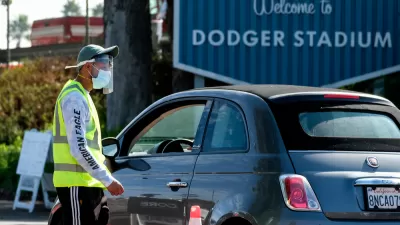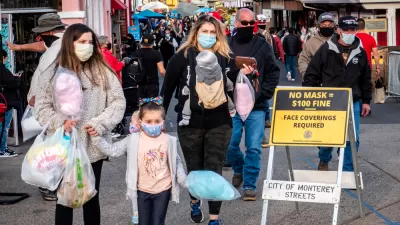The City by the Bay has joined eight largely rural counties in California by advancing last Tuesday to the least restrictive tier of the state's new reopening criteria by reducing coronavirus transmission to nearly New York levels.

California suffered through the summer coronavirus surge that largely affected the South and West, where cases and hospitalizations increased dramatically. California's coronavirus dashboard shows two distinct peaks of its 14-day rolling average of daily new infections on July 25 and August 19 of nearly 9,500 and 8,200, respectively.
On August 28, Gov. Gavin Newsom retooled the reopening framework, creating a four-tiered system for the state's 58 counties, based largely on two health metrics: daily infections per 100,000 people, i.e., incidence, as determined by the results of diagnostic testing, and the test positivity rate: the ratio of positive test results to total tests administered.
By Oct. 17, the state's 14-day rolling average of new cases had dropped to just over 3,100. Evan Webeck of the Bay Area News Group reported on Oct. 18 (source article) that California has seen the daily rate of new infections drop to 10 per 100,000 people while nationwide coronavirus cases increased by 25% during the past two weeks.
California ranked #42 on the Harvard Global Health/Brown School of Public Health COVID Risk Levels Dashboard with 11 daily new cases per 100k (7-day moving average) based on Oct. 24 data, with North Dakota #1 with 105 cases, the U.S. average at 20 cases, New York #45 with 8 cases, and Maine #51 with 2.4 cases.
Health experts took notice of California's plunging infections.
Jha credited the state’s “huge boost” in testing and county-by-county “micro-targeting” as “smart policies” that have helped control the virus. California has averaged nearly 124,000 COVID-19 tests each day for the past two weeks.
“Instead of approaching lockdowns as light switch (on or off), CA approach is that of a dimmer switch…Obviously we don’t know if it will last but so far, so good,” he wrote.
Sadly, it doesn't appear to be lasting. Like the rest of the nation, cases are rising in the Golden State, with the 14-day average of daily new infections over 3,600 on Oct. 25. How high it goes will be determined by people's behavior, not the density of where they live, as Webeck noted in the third paragraph of his piece.
The reasons why [infections have plunged], health experts say, are made clear by a stroll through San Francisco. Pedestrians are masked and passing each other at acceptable social distances. Painted circles partition off small groups at one of the city’s most popular parks.
“If you social distance and you wear masks, you decrease the cases dramatically,” said Dr. John Swartzberg, an infectious disease expert and professor emeritus at UC Berkeley. “A culture that accepts the science and follows it is going to do better.”
San Francisco drops a tier
"San Francisco [last] Tuesday became the first major jurisdiction in California to advance into the state’s least-restrictive yellow reopening tier, Dr. Mark Ghaly, the Secretary of Health and Human Services, said in a series of announcements," reported Webeck on Oct. 20. The city was one of six Bay Area counties on March 17 that were first in the nation to shelter-in-place to slow the spread of the virus.
At 0.8%, the positivity rate in San Francisco is one of the lowest in California. The city is also testing more of its residents per-capita than any other jurisdiction in the state. That allowed it to further reduce its case rate, using a modifier in the state’s calculation, from 2.5/100K to 1.5/100K, according to data from CDPH.
According to the state's new reopening criteria known as Blueprint for a Safer Economy, the yellow or "minimal" restriction tier requires less than one daily new case per 100k and less than 2% test positivity. Accordingly, "[m]ost indoor business operations are open with modifications."
Dr. Erica Pan, California’s public health officer, said San Francisco benefited from the new health equity metric, which requires the positivity rates in the most disadvantaged communities to be within a certain percentage of the countywide average.
"Experts credit San Francisco’s success to a long partnership between public health officers and universities, most notably during the AIDS crisis," reports San Francisco-based Maura Dolan in an extensive piece describing the city's success for the Los Angeles Times on Oct. 25.
Nina Bai with U.C. San Francisco wrote in July about how the city's AIDS epidemic response helped prepare them for COVID-19.
In that sense, San Francisco, America's second densest large city after New York, shares a similarity with the successful responses of its dense East Asian counterparts in Hong Kong, Taiwan, Singapore, and Vietnam that had memories of dealing with the more fatal, though less contagious, SARS (Severe Acute Respiratory Syndrome) coronavirus in 2003, and South Korea, which dealt with a more recent deadly coronavirus, Middle East Respiratory Syndrome (MERS), in 2015.
San Francisco, with its 882,000 residents living on 47 square miles, joined six of the state's least populous counties, all less than 20,000, plus Siskiyou (pop. 45,000) and Humboldt (pop. 136,000) counties in the "minimally restrictive" tier which permits most indoor operations to open with modifications.
"City officials still are not declaring victory," adds Dolan of the Times.
Characteristically, they warn, the virus still lurks around the corner. And as they have before, they will follow local metrics rather than reopen just because the state allows it.
Related in Planetizen:
- Another Grim Coronavirus Milestone: This Time in Southern California, August 19, 2020
- California Rolls Back, July 14, 2020
- California's Coronavirus Infections and Hospitalizations Surge, July 3, 2020
- Reopening California: Respected County Health Official Issues Warning, May 31, 2020
- The Rush to Open: California is No Exception, May 7, 2020
FULL STORY: Eight months in, California is containing COVID-19 as other states spike. Here’s why.

Planetizen Federal Action Tracker
A weekly monitor of how Trump’s orders and actions are impacting planners and planning in America.

Chicago’s Ghost Rails
Just beneath the surface of the modern city lie the remnants of its expansive early 20th-century streetcar system.

San Antonio and Austin are Fusing Into one Massive Megaregion
The region spanning the two central Texas cities is growing fast, posing challenges for local infrastructure and water supplies.

Since Zion's Shuttles Went Electric “The Smog is Gone”
Visitors to Zion National Park can enjoy the canyon via the nation’s first fully electric park shuttle system.

Trump Distributing DOT Safety Funds at 1/10 Rate of Biden
Funds for Safe Streets and other transportation safety and equity programs are being held up by administrative reviews and conflicts with the Trump administration’s priorities.

German Cities Subsidize Taxis for Women Amid Wave of Violence
Free or low-cost taxi rides can help women navigate cities more safely, but critics say the programs don't address the root causes of violence against women.
Urban Design for Planners 1: Software Tools
This six-course series explores essential urban design concepts using open source software and equips planners with the tools they need to participate fully in the urban design process.
Planning for Universal Design
Learn the tools for implementing Universal Design in planning regulations.
planning NEXT
Appalachian Highlands Housing Partners
Mpact (founded as Rail~Volution)
City of Camden Redevelopment Agency
City of Astoria
City of Portland
City of Laramie





























